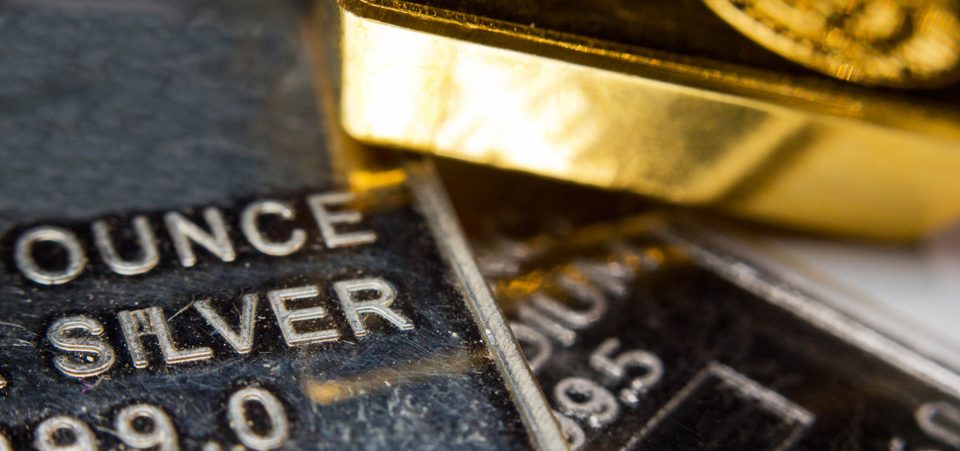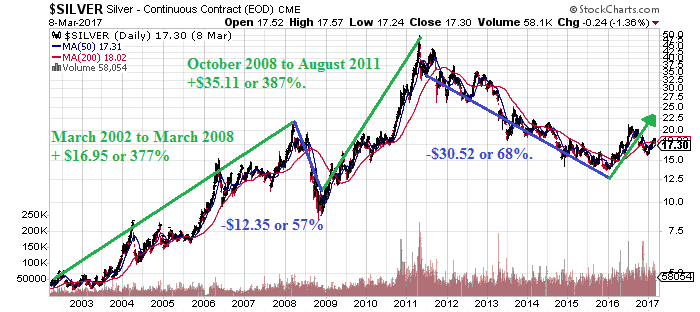Should You Invest in Gold and Silver in 2017?
Should you invest in gold or silver in 2017? While gold bears are saying the previous metals rally is over and it’s time to dump gold and silver, there are more than enough compelling reasons why investors should remain bullish on silver and gold prices in 2017. For those long on precious metals in 2017 and wondering how to invest in gold and how to invest in silver, there is a wide variety of investments to consider.
The first half of 2016 was great for gold and silver. By early July, silver had advanced 53% to a two-year high of around $21.23 per ounce; over the same time period, gold increased approximately 30% to $1,377 per ounce. Precious metals rallied on fears of a global economic slowdown and growing concerns that the Federal Reserve may have raised its key lending rate prematurely.
Chart courtesy of StockCharts.com
In the second half of 2016 though, precious metals gave up solid ground. Silver ended 2016 up 15.7% at $15.99 per ounce while gold finished the year up 8.5% at $1,151 an ounce. Gold and silver faced pressure after Donald Trump won the November election. Investors believed his economic policies, tax cuts, and infrastructure spending would provide the U.S. with a much needed economic jolt that would also benefit corporate earnings.
That remains to be seen, of course. And investors are not necessarily willing to throw caution to the wind just yet and trust their retirement portfolio with President Trump. Yes, stocks may be at record levels and investors sentiment is running strong, but so too are precious metals. Silver prices were up 15.6% at the end of February at $18.47 an ounce while gold prices were also bullish, up 9.3% at $1,258 per ounce.
The bullish sentiment for precious metals remains despite the fact the Federal Reserve is expected to implement the first of three proposed rate hikes at its next meeting in the middle of March.
The Fed said it would raise benchmark U.S. interest rates as long as jobs and inflation data remains robust. This of course does not bode well for gold or silver. Higher U.S. rates is a boost of confidence for the U.S. economy, which will boost the U.S. dollar and diminish the need for non-bearing assets like gold and silver.
No sense hedging against economic uncertainty when the Fed’s going to raise rates, right? Wrong. The U.S. economy is not doing nearly as well as the headlines say. Moreover, President Trump’s economic policies may not bear fruit. In fact, Trump’s tax cuts, increased spending, and trade policies could make the already massive national debt even “yuger.” Further, ongoing geopolitical tensions in North Korea and the Middle East and uncertainty about upcoming European elections will continue to boost the demand for gold and silver.
It’s still the early days of 2017, but when you take into account all of the factors that are bullish for precious metals, a gold price forecast for 2017 of $1,450 per ounce is not out of the question. A silver price forecast for 2017 could see multi-year highs near $25.00 an ounce.
Chart courtesy of StockCharts.com
Gold and Silver Shines as U.S. Economy Remains Shaky
The markets may be at record levels and the Fed is set to raise rates, but investors still need to consider gold and silver as a viable hedge against economic uncertainty.
The U.S. economy is on shaky ground. Donald Trump pledged, on the campaign trail, to get annual GDP at four percent, but that’s going to be a difficult task. The country’s gross domestic product (GDP) advanced just 1.6% in 2016; 2.6% in 2015; 2.4% in 2014; and 1.7% in 2013. Since the Great Recession, GDP has averaged just 2.3%.
During his entire run as President, Obama never saw GDP climb above three percent. One thing that did rise under President Obama was the national debt and deficit. Trump inherited a national debt of almost $20.0 trillion and deficit closing in on $600.0 billion.
The official unemployment rate remains under five percent, but the underemployment rate, which also includes those who are marginally attached and discouraged, is near 10%. Keep in mind, most of the jobs created since the so-called recovery have been low-paying, part-time jobs. It’s hard to champion economic growth and job creation on that.
Wage growth is virtually non-existent and household debt levels are on the rise again, approaching pre-recession levels. Money is so hard to come by for the average American that almost half of the country could would have to borrow to meet a $400.00 emergency expense.
Despite artificially low interest rates, corporate America is also struggling to come up with some much needed cash. Corporate (and personal) bankruptcies are up and more and more businesses are letting people go in an effort to keep their doors open.
Against a backdrop of stagnant wage growth, increased debt, and mediocre job creation, the Fed is poised to raise its key lending rate. While some will say that a 25-basis-point increase in the Federal Funds Rate is not a big deal…it is.
Low interest rates are supposed to spur economic growth, whether Quantitative Easing has achieved that goal is debatable. Conversely, higher interest rates are supposed to cool down the economy. But you need a strong economy first before you can cool it down. We don’t have that.
Again, GDP is anemic. Even the Fed says that the U.S. economy will advance just 2.1% in 2017 and two percent in 2018. Continuing with that downward projection, GDP in 2019 is expected to come in at a princely 1.9%. (Source: “Economic Projections,” Federal Reserve, December 2016.)
This makes sense in a world of rising interest rates. The higher rates are the more expensive it is for businesses and consumers to borrow money. Higher interest rates could also become a serious burden on the U.S. dollar.
A strong dollar is great if you’re travelling and converting your currency, but if you’re corporate America, a strong dollar can kill exports. According to the latest data, 44% of all revenue for S&P 500 companies comes from outside of the United States. This cannot help but take a bite out of revenue and earnings. (Source: “S&P 500: Global Sales,” S&P Dow Jones Indices, last accessed March 6, 2017.)
Investors may be taken aback when they see the economic data roll in the second half of 2017. As a hedge against economic uncertainty, investors will, once again, with the wisdom of hindsight, turn their sights back onto gold and silver.
Trade Tariffs Make Gold and Silver an Attractive Play
The current economic malaise and potential drag on Wall Street earnings and revenue does not even take into account President Trump’s proposed tariffs. President Trump championed his America First pledge during his first address to Congress. His job, as president, is to represent the interest of the U.S. people, not the rest of the world.
What will that look like? No concrete numbers have been announced, but one thing is certain, it’s going to get a lot more expensive for other countries to do business with the U.S. And the rest of the world is hardly doing well economically. In fact, it’s doing worse than the U.S.
President Trump has said he would consider a 20% to 45% tariff on imports from China and Mexico and a five-percent tariff on all goods imported into the U.S from everywhere else. Suffice it to say, broad-based tariffs imposed on imports and retaliation by affected countries, will be a drag on both domestic and international growth. (Source: “Trump is reportedly considering a 5% tariff on all imports,” Business Insider, December 22, 2016.)
Will President Trump’s pro-business policies help corporate America make more money and fuel sustainable economic growth in the U.S., or could it impede growth and even lead to global economic stagnation?
Even Perma-Bull U.S. Banks Have Become Bearish
The stock market is about to celebrate its eighth anniversary, making it the second-longest bull market in history. Over the last eight years, the S&P 500 has more than tripled from its 2009 low of 666. As equities continue to climb higher and higher, investors continue to weigh whether stocks are headed for a serious correction or crash.
Even U.S. banks, the perma-bulls, are beginning to sweat. Three of the country’s biggest banks believe stocks have moved too far, too fast; are overvalued; and are poised for a sell-off.
U.S. stocks are at record levels and investor sentiment is on fire. Even if earnings aren’t. Goldman Sachs Group Inc (NYSE:GS) noted recently that the S&P 500 is up more than 20% over the last year with roughly half of those gains coming since the November election. It’s also been a year since the stock market experienced a 10% correction. In the midst of this 10% gain, corporate earnings estimates for 2017 have fallen by one percent. (Source: “Goldman Sachs Warns U.S. Stocks Are Now Reaching Peak Optimism,” Bloomberg, February 21, 2017.)
Citigroup Inc (NYSE:C) believes overly enthusiastic investors are getting ahead of themselves. Analysts at the bank actually believe investors should take profits. If the current rally continues, they should short the market. Why is Citigroup so bearish? As one manager put it, “What’s a manager supposed to do when by early March your asset class has already exceeded your expectation for full-year returns?” He advises clients should sell and take profits. (Source: “Citigroup Analyst Says It’s Time To Sell,” ETF Daily News, March 6, 2017.)
Finally, an analyst at JPMorgan Chase & Co. (NYSE:JPM) believes that, over the medium turn, stock will continue to climb on Trump’s pro-growth strategies and “solid fundamental.” But in the near-term, the bank sees increasing risk of a selloff as a result of the Federal Reserves’ hawkish tone and increased volatility. (Source: “Stock market retreats as financials, geopolitical jitters weighs,” MarketWatch, March 6, 2017.)
If the banks are worried investors should at least sit up and pay attention. But are their fears justified? On the most basic level, yes, stocks are seriously overvalued. The Case-Shiller CAPE ratio is currently at 29.6; the 10-year average is 16. That suggests the S&P 500 is overvalued by 85%. The ratio has only been higher twice: 1929 and 1999. In 1929, it was at 30. In 1999, it was at 45. (Source: “Case Shiller P/E Ratio,” Yale University, last accessed March 6, 2017.)
If there’s one thing that can send precious metal shy investors back into gold and silver, it’s a stock market sell-off.
Gold and Silver Bulls Never Bet Against North Korea
Geopolitical factors can also have an immediate impact on gold and silver prices. And there are a lot of geopolitical issues out there that could positively impact the gold and silver price forecast for 2017.
As ever, investors can count on Kim Jong-un, North Korea’s insecure, fashion forward, butter-ball leader to keep tensions high. After having his amiable, estranged half-brother assassinated in February, Kim Jong-un ratcheted up the geopolitical discourse by launching four banned missiles that traveled 600 miles into the ocean near South Korea.
North Korea launched the missiles at the same time as the U.S. and South Korea organize joint military exercises. Alas, North Korea has warned that “the most undisguised nuclear war maneuvers,” are driving the world toward “nuclear disaster.” (Source: “North Korea fires four ballistic missiles into Sea of Japan,” CNN, March 6, 2017.)
On top of ongoing issues with North Korea, China has lowered its GDP estimates, and growth is weak in both Europe and Japan. Investor’s don’t even need to look beyond our own borders for some gold and silver bolstering political uncertainty. There is growing uncertainty about upcoming elections in France, Italy, and Germany, and here at home, President Trump has accused Obama of pre-election wiretapping.
All of this uncertainty has the potential the push down the U.S. dollar and send gold and silver prices higher.
Best Ways to Profit from Rising Gold and Silver Prices
There are a number of different ways investors can take a position in silver and gold. Five of the best ways to invest in gold include physical gold (bullion and coins), gold exchange traded funds, gold mining stocks, gold mutual funds, and gold options and futures.
If you’re interested in silver, consider buying silver from the bank or a precious metals dealer: either in person on online. Silver mining stocks and silver exchange traded funds are also a great way to get exposure to silver. One of the best ways to invest in silver is with a silver streaming company. Unlike a silver mining company, a silver streaming company doesn’t mine for silver but buys it from a mining company to refine and distribute at a price far lower than the market price.
Don’t let the second-longest bull market in history, record stock levels, and a hawkish Federal Reserve distract you. There are a lot of reasons to be bullish on gold and silver in 2017.








